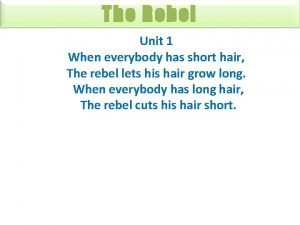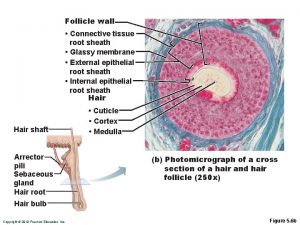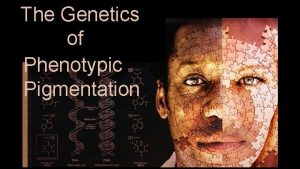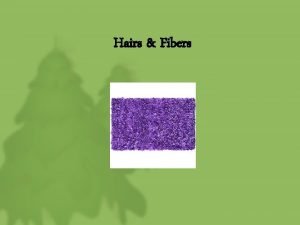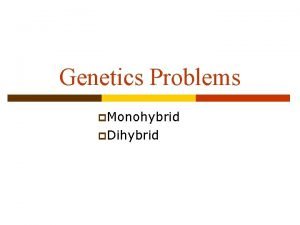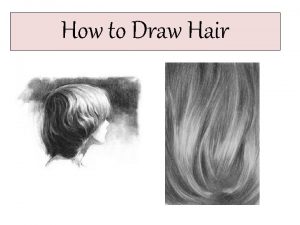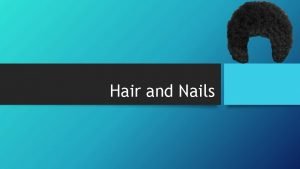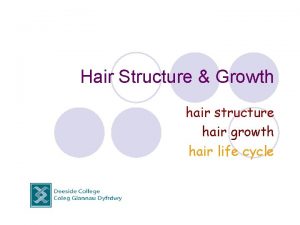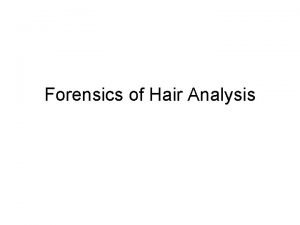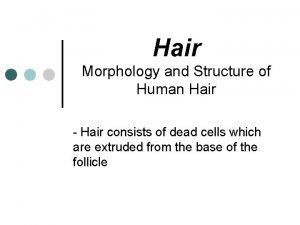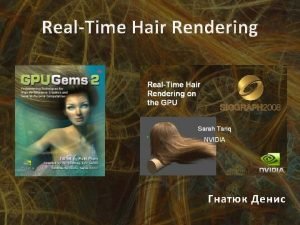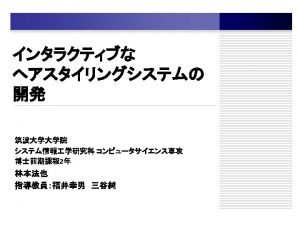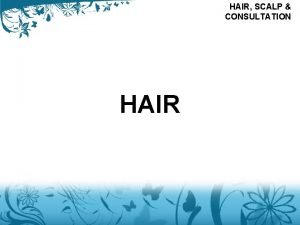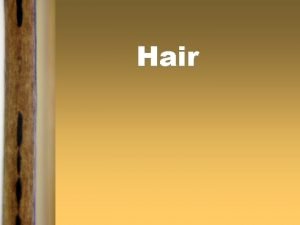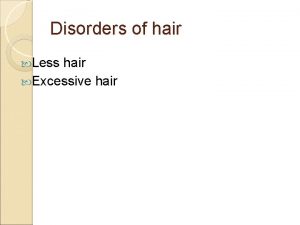How to Draw Hair Draw the outline of
















- Slides: 16

How to Draw Hair

• Draw the outline of the hair. Make sure you know where the top and the back of the skull is. • Add big lines in the hair indicating the planes of the hair masses. Look at your subject and use measuring techniques, measuring will ensure you get the boundaries of the hair right.

Look for the general shadow and light patterns. Divide the tonal relationship in two shades: dark and light. Do the shading by tilting the pencil, instead of using the tip of the pencil. This way you can cover the areas rapidly and save time.

• Differentiate among the tones within the shadow. By squinting at the picture of the subject, You will see more shades within that mass and shade accordingly. Compare one shade with one another for a unified value(tonal) relationship. Without it, the hair will not look real. • Blonde hair in shadow will look dark, but not as starkly dark as that of a person with darker hair. Darken the crevices around the face and behind the ears to make the hair recede properly. • look for those details like bands, curls, or waves. Refine their individual shapes only after you finish the overall shadow pattern on which these tiny shapes are located. • Remember that big shapes always come first before you add any 'details'. • Use a kneaded eraser to draw the curly hair instead of the tip of the pencil.

Instead of delineating the strands of hair, darken its surroundings and the wavy hair comes forward! Look for other wavy hair and treat it the same way: using an eraser, darken the tones around them and refine their shapes if needed.

Finishing • Look for more variations among the dark, middle, and light tones until you can’t find anything more. • Use your finger to smooth out the shading and soften harsh lines between shapes in the hair. Remember that there are no sharp edges on human hair! Well, most of the time!

Spherical Skull Most hair styles you will draw will be affected by the skull underneath. So, it’s important to think of the ball when working on the overall value changes.

Common Mistakes when Drawing Hair Forgetting about the volumes This is the most common mistake I see from newer students. There are over 100, 000 strands of hair on our heads. This thought can be very distracting from the goal of 3 -dimensionality. So, some people forget about volume and draw a bunch of lines. But, lines don’t create the illusion of volume. Gradations and value differences that show plane changes create the illusion of volume. Don’t draw a bunch of lines. Instead, focus on the volumes.

Too Much Texture • This one is similar to the first, but this can still happen even if one pays attention to the volumes. Too many repeating lines everywhere (in the lights, halftones, and shadows) can get very distracting. There need to be areas of rest, especially since you want the focus to stay on the face not the hair. I usually show the texture of the hair in the lights and choose to keep the shadows simplified. But it depends. If I’m drawing blonde hair with a strong light source, I might choose to blow out the lights and show the texture in the shadows.

Impatience - Bad Design • There are so many random little shapes in hair, that good design is a necessity. All the shapes can be intimidating and it’s easy to get impatient and sloppy. I’ve found that confidence is an important element for good design. Approach the hair with purpose and a sense of know-how.

Sharp Outlines • I’m referring the outer edge between the hair and background also the connection between hair and skin. Unless the subject has a perfectly combed or gelled hairstyle, there will be stray strands that soften the edge between the background. • But even if I see a sharp outlined edge, I will cheat in softer edges for variation. This also adds depth and atmosphere and connects the subject to the environment. Variation in edge is also important in the areas connecting the skin. Drawing a sharp outline will make it look like a wig or a clip-on beard.

Here’s an example of a lock of hair simplified to its basic form: It doesn’t look like hair, but it does look 3 -dimensional. To make it look like hair we need to add the 4 th element of texture. This includes the separations between the smaller groups of hair, a few lines representing strands, and breaking up the contours. Now that we’ve established the 4 elements necessary to create the illusion of hair, let’s look at each individually:


Texture • Some tips when drawing the hair texture: • Get the illusion of the strands. Don’t try to draw every single strand. • Have confidence with every stroke. It’s better to draw a quick confident strand slightly out of place, then a wobbly stroke in the right place. Don’t be timid. This happens when drawing strands that drop down the forehead. People don’t want to mess up the face. But, it doesn’t matter if it’s in the perfect spot… Hair moves. • Start the stroke at the root and let it taper towards the tip. • Generally, lines should be lighter and thinner at the highlights. • If working with graphite, use a combination of softer duller pencils and harder sharp pencils. For example a dull 4 B for larger soft gradations and a sharp HB for more defined shapes. Watch out - sometimes a pencil that is too soft will cause the texture of the paper to show through. This ruins the illusion of hair texture, since hair texture is made of long flowing lines and paper texture is usually small repetitive dots.


Sketchbook Assignment Draw this girl. (isn’t she cute? ) Draw and shade her hair Start with the base overall tone, Then block in the large shapes of values Next look for the darkest areas and Fill those in. Erase for the high lights Add some texture.
 When everyone has short hair rebels wants
When everyone has short hair rebels wants Glassy membrane
Glassy membrane Hair grows in diagonal tubes called hair
Hair grows in diagonal tubes called hair The two primary parts of hair are the hair fiber and the:
The two primary parts of hair are the hair fiber and the: Dark hair and blonde hair parents
Dark hair and blonde hair parents Difference between animal and human hair
Difference between animal and human hair What is tacheometric survey
What is tacheometric survey Heterozygous short-hair x heterozygous short-hair
Heterozygous short-hair x heterozygous short-hair Hair outline
Hair outline Topic sentence outline example
Topic sentence outline example điện thế nghỉ
điện thế nghỉ Một số thể thơ truyền thống
Một số thể thơ truyền thống Biện pháp chống mỏi cơ
Biện pháp chống mỏi cơ Trời xanh đây là của chúng ta thể thơ
Trời xanh đây là của chúng ta thể thơ Bảng số nguyên tố
Bảng số nguyên tố Thiếu nhi thế giới liên hoan
Thiếu nhi thế giới liên hoan Tỉ lệ cơ thể trẻ em
Tỉ lệ cơ thể trẻ em
